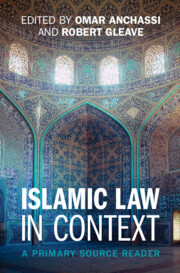Book contents
- Islamic Law in Context
- Islamic Law in Context
- Copyright page
- Contents
- Acknowledgements
- Contributors
- Introduction
- Part I Islamic Legal Theory (Uṣūl al-Fiqh) and Related Genres
- Chapter 1 Introduction to Part I
- Chapter 2 The Foundation of Analogy
- Chapter 3 The Insufficiency of Concomitance Alone
- Chapter 4 Selections from al-Manthūr fī l-Qawāʿid of Badr al-Dīn al-Zarkashī (d. 794/1392)
- Chapter 5 ‘Is Every Mujtahid Correct?’ and the Implications of Holding Incorrect Theological Beliefs for one’s Fate in the Hereafter, from the Qawānīn al-Uṣūl of Mīrzā al-Qummī (d. 1231/1816)
- Chapter 6 The ‘Innovation’ of Legal School Affiliation
- Part II Islamic Jurisprudence (Fiqh) and Related Genres
- Part III Legal Opinions (Fatwās)
- Part IV Court Judgments and Other Court Documentation
- Part V Judicial Manuals and Reference Books
- Part VI Alternative Sources for Islamic Legal Studies
- Name Index
- Subject Index
- References
Chapter 3 - The Insufficiency of Concomitance Alone
‘Co-Presence and Co-Absence’ in the Mukhtaṣar of Ibn al-Ḥājib (d. 646/1249), with Commentary from the Sharḥ of al-Ījī (d. 756/1355) and the Ḥāshiya of al-Taftāzānī (d. 793/1390)
from Part I - Islamic Legal Theory (Uṣūl al-Fiqh) and Related Genres
Published online by Cambridge University Press: 14 November 2024
- Islamic Law in Context
- Islamic Law in Context
- Copyright page
- Contents
- Acknowledgements
- Contributors
- Introduction
- Part I Islamic Legal Theory (Uṣūl al-Fiqh) and Related Genres
- Chapter 1 Introduction to Part I
- Chapter 2 The Foundation of Analogy
- Chapter 3 The Insufficiency of Concomitance Alone
- Chapter 4 Selections from al-Manthūr fī l-Qawāʿid of Badr al-Dīn al-Zarkashī (d. 794/1392)
- Chapter 5 ‘Is Every Mujtahid Correct?’ and the Implications of Holding Incorrect Theological Beliefs for one’s Fate in the Hereafter, from the Qawānīn al-Uṣūl of Mīrzā al-Qummī (d. 1231/1816)
- Chapter 6 The ‘Innovation’ of Legal School Affiliation
- Part II Islamic Jurisprudence (Fiqh) and Related Genres
- Part III Legal Opinions (Fatwās)
- Part IV Court Judgments and Other Court Documentation
- Part V Judicial Manuals and Reference Books
- Part VI Alternative Sources for Islamic Legal Studies
- Name Index
- Subject Index
- References
Summary
This chapter explores the discussion of the utility of co-presence and co-absence (al-ṭard wa-l-ʿaks) - a.k.a. concomitance (dawarān) - in determining whether a property is a cause (ʿilla) of its associated ruling (ḥukm) in the famous Mukhtaṣar of Ibn al-Ḥājib (d. 646/1249), as well as in the commentary of ʿAḍud al-Dīn al-Ījī (d. 756/1355) and its gloss by Saʿd al-Dīn al-Taftāzānī (d. 793/1390). This issue, while seemingly abstract, is vitally important to the proper application of causal qiyās. For this type of qiyās to be a legitimate method for deriving legal norms, one first needs to determine the cause of the rule in an authoritatively established case (called the ‘root-case,’ or aṣl). Only then can that rule be transferred to the disputed case (the ‘branch-case,’ or farʿ) in which the self-same cause exists. Arguments from concomitance (dawarān) are based on a knowledge that wherever the presumed causal property exists the legal norm exists (‘co-presence’), and wherever this property does not exist the legal norm does not exist (‘co-absence’).
Keywords
- Type
- Chapter
- Information
- Islamic Law in ContextA Primary Source Reader, pp. 33 - 46Publisher: Cambridge University PressPrint publication year: 2024

